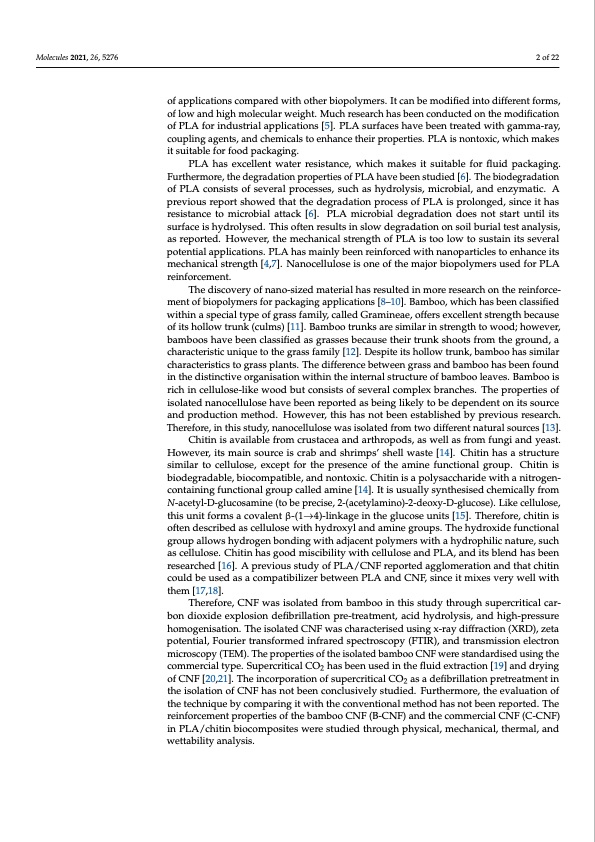
PDF Publication Title:
Text from PDF Page: 002
Molecules 2021, 26, 5276 2 of 22 of applications compared with other biopolymers. It can be modified into different forms, of low and high molecular weight. Much research has been conducted on the modification of PLA for industrial applications [5]. PLA surfaces have been treated with gamma-ray, coupling agents, and chemicals to enhance their properties. PLA is nontoxic, which makes it suitable for food packaging. PLA has excellent water resistance, which makes it suitable for fluid packaging. Furthermore, the degradation properties of PLA have been studied [6]. The biodegradation of PLA consists of several processes, such as hydrolysis, microbial, and enzymatic. A previous report showed that the degradation process of PLA is prolonged, since it has resistance to microbial attack [6]. PLA microbial degradation does not start until its surface is hydrolysed. This often results in slow degradation on soil burial test analysis, as reported. However, the mechanical strength of PLA is too low to sustain its several potential applications. PLA has mainly been reinforced with nanoparticles to enhance its mechanical strength [4,7]. Nanocellulose is one of the major biopolymers used for PLA reinforcement. The discovery of nano-sized material has resulted in more research on the reinforce- ment of biopolymers for packaging applications [8–10]. Bamboo, which has been classified within a special type of grass family, called Gramineae, offers excellent strength because of its hollow trunk (culms) [11]. Bamboo trunks are similar in strength to wood; however, bamboos have been classified as grasses because their trunk shoots from the ground, a characteristic unique to the grass family [12]. Despite its hollow trunk, bamboo has similar characteristics to grass plants. The difference between grass and bamboo has been found in the distinctive organisation within the internal structure of bamboo leaves. Bamboo is rich in cellulose-like wood but consists of several complex branches. The properties of isolated nanocellulose have been reported as being likely to be dependent on its source and production method. However, this has not been established by previous research. Therefore, in this study, nanocellulose was isolated from two different natural sources [13]. Chitin is available from crustacea and arthropods, as well as from fungi and yeast. However, its main source is crab and shrimps’ shell waste [14]. Chitin has a structure similar to cellulose, except for the presence of the amine functional group. Chitin is biodegradable, biocompatible, and nontoxic. Chitin is a polysaccharide with a nitrogen- containing functional group called amine [14]. It is usually synthesised chemically from N-acetyl-D-glucosamine (to be precise, 2-(acetylamino)-2-deoxy-D-glucose). Like cellulose, this unit forms a covalent β-(1→4)-linkage in the glucose units [15]. Therefore, chitin is often described as cellulose with hydroxyl and amine groups. The hydroxide functional group allows hydrogen bonding with adjacent polymers with a hydrophilic nature, such as cellulose. Chitin has good miscibility with cellulose and PLA, and its blend has been researched [16]. A previous study of PLA/CNF reported agglomeration and that chitin could be used as a compatibilizer between PLA and CNF, since it mixes very well with them [17,18]. Therefore, CNF was isolated from bamboo in this study through supercritical car- bon dioxide explosion defibrillation pre-treatment, acid hydrolysis, and high-pressure homogenisation. The isolated CNF was characterised using x-ray diffraction (XRD), zeta potential, Fourier transformed infrared spectroscopy (FTIR), and transmission electron microscopy (TEM). The properties of the isolated bamboo CNF were standardised using the commercial type. Supercritical CO2 has been used in the fluid extraction [19] and drying of CNF [20,21]. The incorporation of supercritical CO2 as a defibrillation pretreatment in the isolation of CNF has not been conclusively studied. Furthermore, the evaluation of the technique by comparing it with the conventional method has not been reported. The reinforcement properties of the bamboo CNF (B-CNF) and the commercial CNF (C-CNF) in PLA/chitin biocomposites were studied through physical, mechanical, thermal, and wettability analysis.PDF Image | Supercritical Carbon Dioxide Isolation of Cellulose Nanofibre

PDF Search Title:
Supercritical Carbon Dioxide Isolation of Cellulose NanofibreOriginal File Name Searched:
molecules-26-05276-v2.pdfDIY PDF Search: Google It | Yahoo | Bing
Sulfur Deposition on Carbon Nanofibers using Supercritical CO2 Sulfur Deposition on Carbon Nanofibers using Supercritical CO2. Gamma sulfur also known as mother of pearl sulfur and nacreous sulfur... More Info
CO2 Organic Rankine Cycle Experimenter Platform The supercritical CO2 phase change system is both a heat pump and organic rankine cycle which can be used for those purposes and as a supercritical extractor for advanced subcritical and supercritical extraction technology. Uses include producing nanoparticles, precious metal CO2 extraction, lithium battery recycling, and other applications... More Info
| CONTACT TEL: 608-238-6001 Email: greg@infinityturbine.com | RSS | AMP |